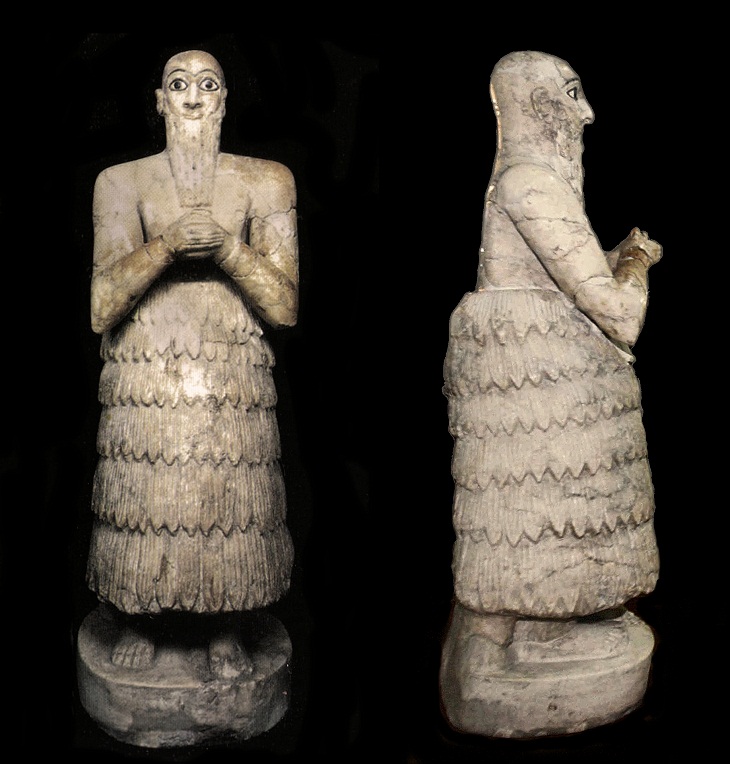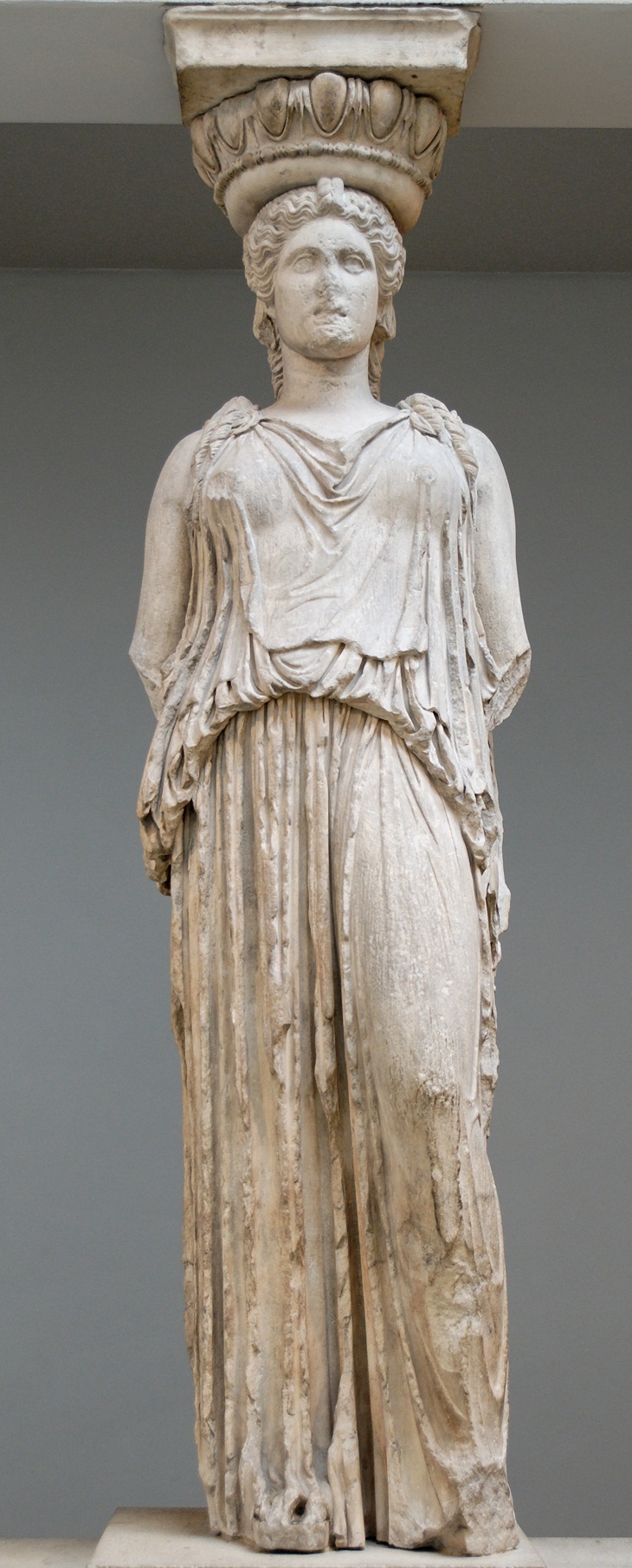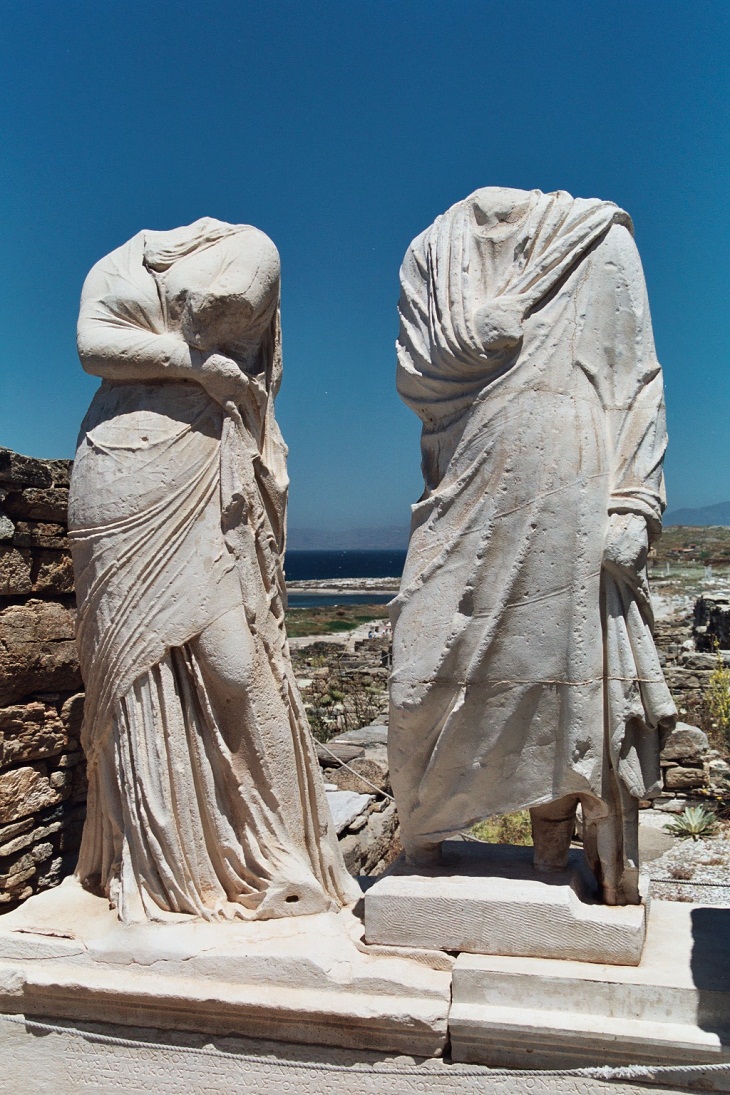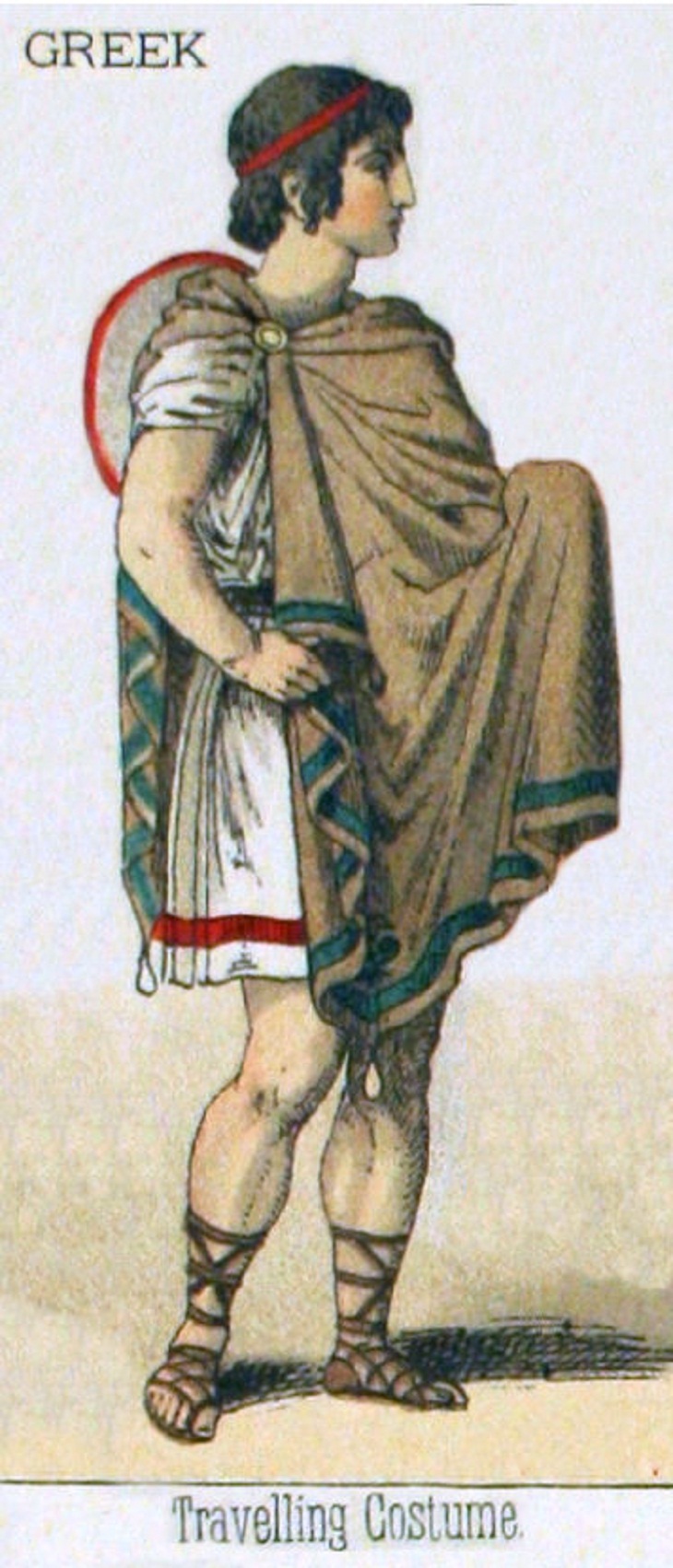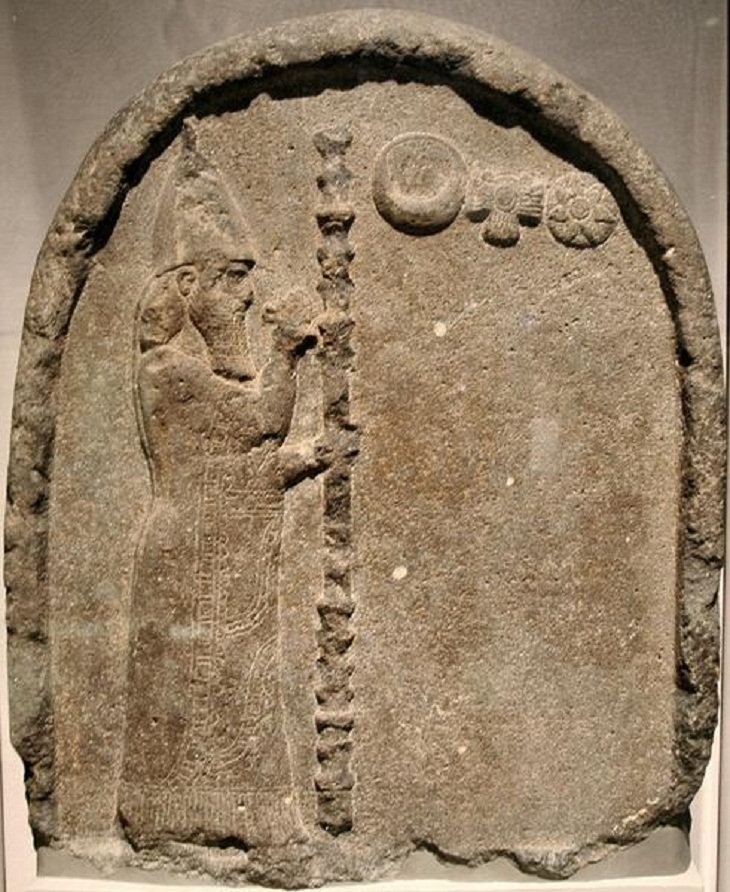Sumerian Iku Shamagan Mari Temple of Ninni-zaza Statue (Image source:
Wikimedia Commons)
Women's Clothing
The women of ancient Sumer wore long dresses that left a single arm and shoulder visible. The left arm was generally hidden.
The kaunakes, the earliest type of dress, was an important part of women’s fashion in this era. This garment covered the shoulders and arms and was stitched or knotted together in horizontal bands using leather pieces to create a wrap skirt.
François Boucher elaborates in 20,000 Years of Fashion (1987):
“In the oldest representations of humans, which date from the third millennium, the skins of various wild animals, formerly worn over the shoulders, were now draped round the hips like a skirt; these garments were made from long-haired skins, particularly sheepskins whose texture is represented by hatched patterns, from 2900 to about 2500 BC in Mesopotamia (Sumer and Akkad).”
The luxury attires of ancient Sumerian women usually consisted of a tunic lined with fringe at the lower end. A rolled shawl embossed with metallic embroidery would be placed at the top. The neckline of the luxury dress would be held by a splint.

Votive Statue of Eannatum, Prince of Lagash (2600-2340 BC), Sumer (Image source: Facebook/Mesopotamia)
Men’s Clothing
Sumerian men initially wore wool or fur kilts to cover the lower body. These kilts had stylized patterns sectioned by horizontal patches. At the beginning of the third millennium, men started wrapping a shawl of narrow tufts around their waists in a long kilt.
With time, men too began wearing kaunakes. Sumerian royalty was known to wear long kaunakes, while the priests wore them below the knee. Some rich men draped shawls over their shoulders as separate garments.
Servants and men from the town wore short skirts fastened by an embroidered belt.
Related: 8 Influential Ancient Sumerian Inventions You Should Know
2. Ancient Egyptian Clothing
Egyptian history can be loosely divided into three periods: the Old Kingdom (about 2,700-2,200 B.C.), the Middle Kingdom (2,050-1,800 B.C.), and the New Kingdom (1,550-1,100 B.C.).
Clothing in Ancient Egypt was directly influenced by the region’s warm and dry climate. People usually wore clothes made almost entirely of linen, fashioned from the flax that grew along the Nile River. Interestingly, cotton was initially used to make clothes, but the people shifted to linen because of the belief that it was purer. More importantly, it was light and airy, and it felt cool in the hot desert.
At first, wool was thought to be impure in ancient Egypt, as all animal fibers were taboo. However, after the conquest of Alexander the Great, wool was used a lot more regularly in everyday garments.
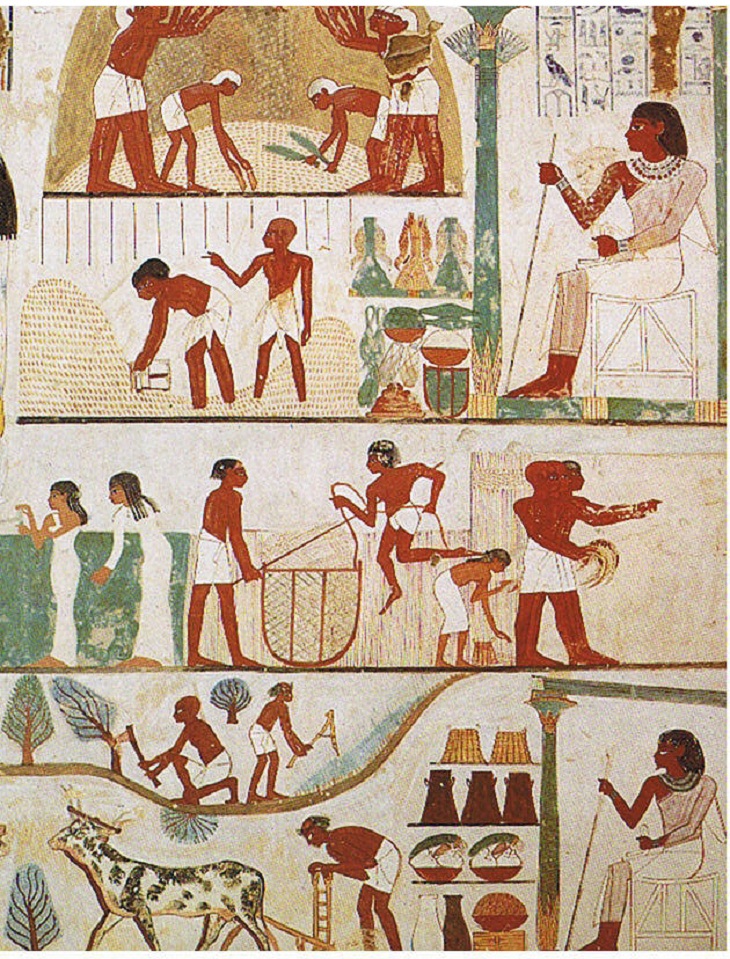
Women’s Clothing
Women in ancient Egypt typically wore more conservative clothing than men. They wore long skirts with a very high waist with one or two straps on the shoulder. They also wore cloak-like garments that covered their shoulders, as well as shawls, capes, or robes over the dresses. Their dresses were adorned with beads or feathers.
The attire of affluent women was exclusively fashioned from fine and almost see-through linen. The dresses were often decorated with beads and gold thread, held together with belts. The shawl, often made of pleated material, was very popular among upper-class women in the New Kingdom.
Working women wore larger clothes, but female servants wore no clothing at all.
Men’s Clothing
Men wore a kilt-like skirt fastened at the waist with a belt, sometimes with a shirt that came to the knees. These garments were sometimes decorated with beads and designs made of gold thread.
Pharaohs wore half-pleated kilts with a pleated section drawn to the front. They also adorned animal skins and leopard skins over their shoulders. Many had a lion's tail hanging from their belt.
Priests wore white linen only, and any garments made from wool were banned in temples and shrines.
Peasants, workers, and people from the lower classes used to wear the shenti, a loincloth consisting of a kind of skirt that was bound at the waist. The shenti was usually worn with a leather belt. By the time the New Kingdom rolled around, they began using a light tunic or a sleeveless shirt.
Accessories
Both men and women in ancient Egypt loved wearing jewelry. They believed it was an important way to enhance their social status and appearance. Jewelry was gold or silver and lined with gemstones like amethyst and turquoise.
The common people wore jewelry made out of colored beads. Egyptians also loved wearing necklaces, bracelets, heavy neck collars, pendants, earrings, rings, and special buttons. Men from the royal family wore headdresses or intricate wigs made of human hair at special events.
3. Ancient Greek Clothing
Unlike ancient Rome and Egypt, clothing in ancient Greece was very simple. During this time, dresses were comprised of rectangular linen or wool fabric and used to be wrapped or draped. They wore light clothes as the climate was hot for most of the year. The construction of their clothes was simple, and most of the clothing came in shades of white.
Related: Ancient Greece: A Quick and Fascinating Overview
Women’s Clothing
Clothing for women in ancient Greece typically comprised of a long tunic called the peplos. The peplos was a loose-fitting draped garment made of a single piece of cloth held up with pins at the shoulder. A part of it was folded down over the belt to give the appearance of two pieces of clothing.
Sara Pendergast in Fashion, Costume and Culture (2004) writes: “The peplos was a simple sleeveless outer garment worn by the women of ancient Greece up to the early part of the sixth century B.C.E (or B.C.). Like many Greek garments, the peplos was formed from one large rectangle of woven fabric, which was folded and pinned in specific ways to become a gracefully draped tunic-like cloak.”
Women sometimes wore a smaller tunic called a chiton under the peplos. The chiton of the women was usually made from imported linen and generally formed from one piece of cloth cloaked around the body. It too was held by a pin at the shoulder. A variation of the chiton could be made of two pieces of fabric tied at the shoulders and down the arms.
In winter, both men and women wore the himation – a large rectangular piece of heavy fabric, either woolen or linen, worn over the peplos. It was draped diagonally over one shoulder like a stole.
Statues at the "House of Cleopatra" in Delos, Greece. Man and woman wearing the himation (Image source:
Wikimedia Commons)
Men’s Clothing
Men generally wore a shorter knee-length chiton, but theirs was much wider than that of women. For exercise, horse riding, or hard labor, men would opt for an exomis – a type of tunic tied on the left shoulder. Young men also loved wearing a chlamys (a short cloak) for riding.
Accessories
Greek men often donned a wide-brimmed hat called petasos during the summer months. A petasos was also used during travels. Women, meanwhile, would wear flat-brimmed hats with high peaked crowns.
Footwear was not commonly used in ancient Greece, as most people walked barefoot, particularly inside their houses. However, when they needed one, both men and women would wear leather sandals or boots, slippers, or soft shoes. Most men and women could go their entire lives without wearing any footwear.
4. Ancient Roman Clothing
The clothing of ancient Romans primarily consisted of the toga, the tunic, and the stola. Most of their clothing was made of wool, but they also used and produced linen and hemp. Silk and cotton were imported from China and India and were hence expensive.
Women’s Clothing
Women wore white clothing made from light materials such as cotton and silk. Their clothing featured a variety of colors, such as deep blue, yellow and red, sea green, and light pink. The most important item of clothing for women was the stola, a long, pleated dress made of linen, cotton, or wool held on by belts. Underneath it, women sometimes wore the strophium, a band of linen or cotton wrapped around the chest to support the breasts.
The tunic was another common garment worn by both men and women. It was like a long shirt, a gown, or an undergarment. Normally, a tunic was sleeveless and was worn with a belt.
Men’s Clothing
The men dressed simply, usually in basic short-sleeved tunics at home. At first, men wore knee-length tunics, but these were later extended to the ankle.
The most significant item in the ancient Roman wardrobe was the toga - a piece of draped cloth made of wool of a semi-circular shape. The toga was basically a large blanket and is believed to have measured 5.5 x 2.75 meters (18 x 9 ft). It was draped over the body, allowing room for one arm to be free. Its enormous size implies that wearing it must have been cumbersome. Togas were also expensive and were reserved only for the well-to-do classes.
According to R. Turner Wilcox’s The Dictionary of Costume (1969): “During the first three centuries of our era, the Roman toga was the principal garment of both sexes but later was worn only by men.”
Accessories
Most people in ancient Rome wore the carbatina, a sandal made of a smooth piece of leather and fastened with a leash. During bad weather, they wore open or closed boots. Women generally wore sandals and boots that reached above the calf.
Jewelry was used by women who wore a variety of items, including rings, bracelets, necklaces, tiaras, earrings, and brooches.
5. Ancient Babylonian Clothing
Babylon was a city-state in ancient Mesopotamia founded around 2300 B.C. Babylonians were groundbreakers in the fields of engineering, architecture, and science.
Babylonians were also known as textile manufacturers and traders. The wool and linen industry was thriving in the region and dominated the clothing of men and women.
Nabonidus, the last king of the Neo-Babylonian Empire. (Image source:
Wikimedia Commons)
Artifacts found in excavations revealed that early Babylonian clothes were composed of waist strings or tiny loincloths covering the crotch and buttocks. With time, their fashion developed into knee-length wrap-around skirts with slanted hemlines. These skirts were typically worn by men and became more artistic over time.
Skirts with tiered fringe were also developed later. These came in bold colors like red, gray, gold, and white. Men also wore tufts of animal skin on their garments; this is a key feature of the Babylonian luxury dress. Women wore long dresses embroidered with fringe and girded with a belt or a band.
Accessories
Babylonian kings adorned their hair with threads of gold in the form of a net. They also used tall cylindrical tiaras with a row of metallic feathers. Royal family members covered their heads with a turban or tarbush, a flat-topped, brimless hat in the shape of a truncated cone. Another royal accessory was a headdress made of a crown or a miter with a short flap in the back.
Rich families loved wearing ornaments such as brooches, hairpins, earrings, necklaces, and anklets. Long earrings in the shape of walnuts, rings, bracelets decorated with geometric figures or flowers, necklaces, and cuffs were quite popular.
Share this post with your friends and family...

